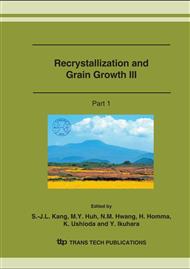p.171
p.177
p.183
p.189
p.195
p.201
p.207
p.213
p.217
The Effect of Grain Size and Rolling Reduction on the Texture Development of a Metastable Austenitic Stainless Steel
Abstract:
It is well known that the deformation and recrystallisation of metals and alloys are accompanied by changes in texture and microstructure. These changes can lead to anisotropy in metal flow and affect the formability of sheet metals. Therefore, a significant amount of research on the development of textures and the principles governing them has been conducted in recent years. One of the most important factors contributing to the texture development of materials is the initial grain size. Unlike other factors such as stacking fault energy, strain and deformation temperature, relatively little work has been carried out on the effect of grain size on texture development, even though a considerable understanding exists regarding the effect of grain size on work hardening and recrystallisation kinetics upon annealing. Hence, this research describes the effect of the initial hot band grain size on the development of texture during cold rolling and subsequent annealing.
Info:
Periodical:
Pages:
195-200
Citation:
Online since:
October 2007
Authors:
Price:
Сopyright:
© 2007 Trans Tech Publications Ltd. All Rights Reserved
Share:
Citation:


